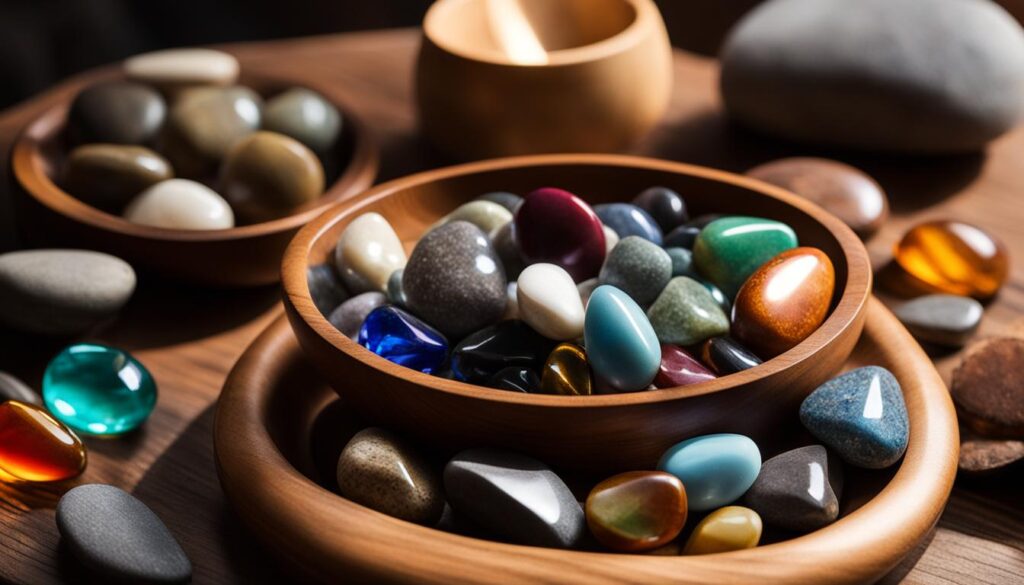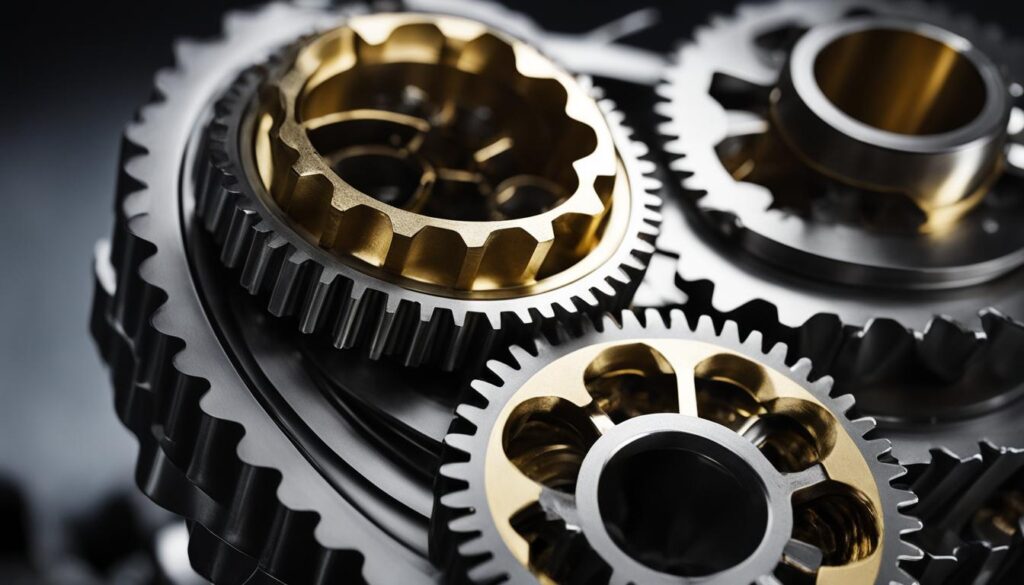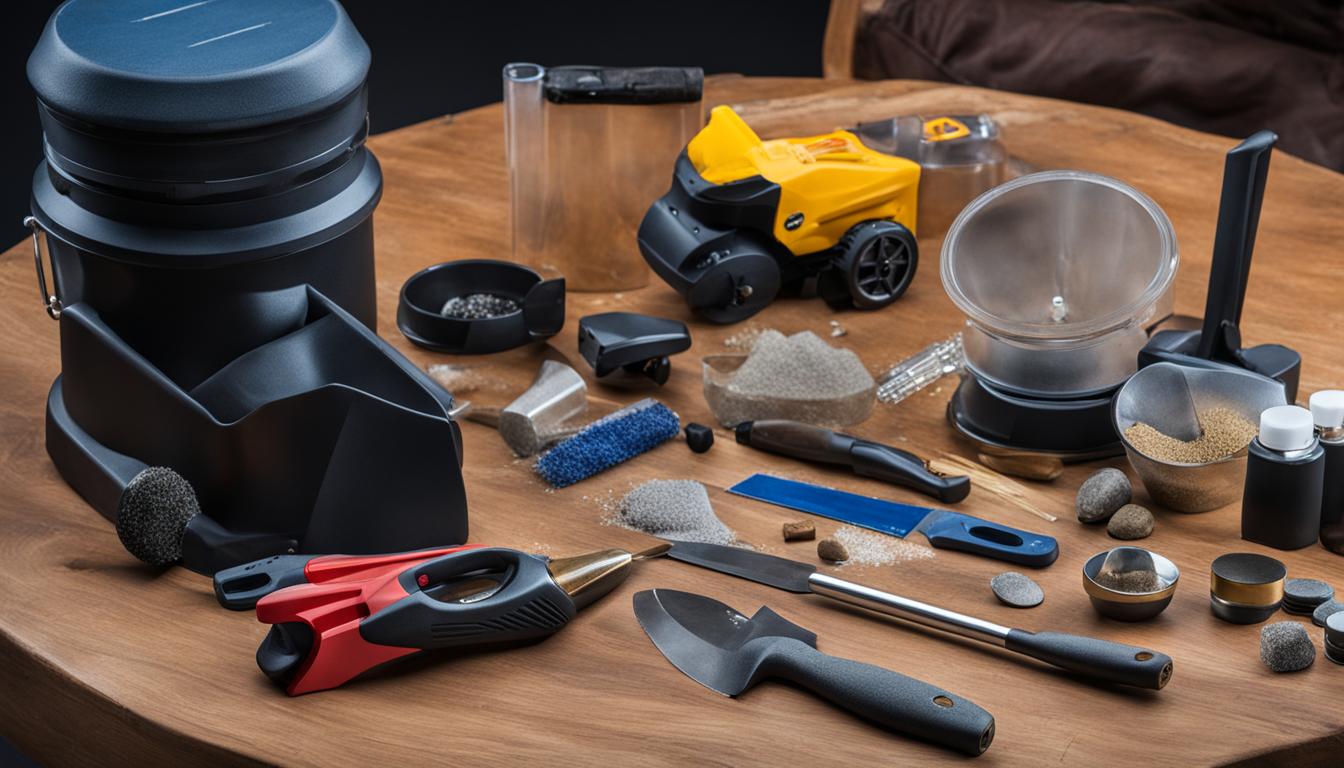This post contains affiliate links.
As an enthusiast of creating treasures from nature’s raw beauty, you understand that the heart of your hobby lies in the maintenance and care of rock tumblers. Whether you’re a seasoned polisher or just beginning, a comprehensive rock tumbler maintenance guide is your secret to preserving both the functionality of your machine and the quality of your finished gems. By dedicating attention to maintaining a rock tumbler, you’re ensuring each tumble results in perfectly polished stones.
Here are the fundamentals: proper upkeep minimizes breakdowns, extends the lifespan of your tumbler, and helps to prevent any cross-contamination of grits that could otherwise compromise your tumbling process. Let’s dive into how you can maintain your rock tumbler effectively to yield stunning results batch after batch.
Key Takeaways
- Consistent maintenance is the linchpin for the enduring performance of your rock tumbler.
- Understanding your machine’s workings underscores the need for tailored care and cleaning habits.
- Following a routine cleaning process post-tumble prevents potential rock contaminations.
- Regular inspections can catch early symptoms of wear, averting costly repairs or replacements.
- Knowing when and how to lubricate your machine will contribute to a smoother tumbling operation.
- Utilizing manufacturer-recommended parts during replacement ensures your tumbler runs as intended.
The Role of Regular Upkeep in Rock Tumbling Success
Ensuring the meticulous upkeep of your rock tumbler not only promises rock tumbler longevity but also elevates the overall tumbling experience. Whether you’re an amateur geologist or an experienced lapidary enthusiast, understanding the pivotal role of regular maintenance can help you achieve dazzling results with each and every tumble.
Ensuring Longevity of Your Equipment
One of the main facets of rock tumbler upkeep is to significantly extend the life of your precious equipment. Every part, from the tiniest bolt to the sturdiest motor, requires your attention. Routine checks and balances guarantee peak performance, saving you from costly repairs or replacements down the line.
Enhancing Safety During Tumbling
Rock tumbler safety is another critical aspect. A well-maintained machine is a safe one, free from unexpected malfunctions or accidents during operation. By following simple safety protocols and keeping your tumbler in tip-top shape, you protect yourself and others around you, ensuring the tumbling process remains a joy, not a hazard.
Consistency in Producing High-Quality Polished Rocks
Quality polished rocks are the pride of any rock-tumbling aficionado. Achieving this consistently is a testament to the dedication put into regular tumbler care. When each component works seamlessly with the others, you create the perfect environment for those raw gems to reach their full lustrous potential.
| Maintenance Task | Frequency | Benefit |
|---|---|---|
| Clean and inspect barrel | After every use | Prevent grit build-up and ensure even tumbling |
| Check and replace belts | Every 6 months or as needed | Prevent slippage and maintain rotation consistency |
| Lubricate bearings and motor | Monthly or after each batch | Reduce noise and wear, prolonging motor life |
| Tighten all nuts and bolts | Bi-yearly | Ensure stability and safety of the tumbler |
Marrying discipline with passion, the routine maintenance of your rock tumbler will serve as the silent force behind the stunning, mirror-like finish on your stones. Invest time into caring for your equipment, and it will surely return the favor with years of rewarding tumbling.
Introducing Your Rock Tumbler: Anatomy and Functionality
Welcome to the fascinating world of the rock tumbling process, where the unseen becomes the cornerstone of your crafting success. Understanding the rock tumbler anatomy and its respective rock tumbler functionality is not just for seasoned geology enthusiasts but also for newcomers eager to dive into this transformative hobby. Let’s unravel the mechanisms that make your rock tumbler an efficient polishing companion.
Understanding the Key Components
The various parts which compose the anatomy of a rock tumbler each play an integral role in turning rough stones into gleaming gems:
- Barrel: This is where the magic happens—a secure container in which your rocks, grit, and water intermingle and tumble their way to smoothness.
- Motor: The power source that causes the barrel to rotate, quietly and steadily simulating the natural rubbing and grinding action found in riverbeds.
- Belts: These transfer the motion from the motor to the barrel, making sure every stone undergoes an even transformation.
- Bearings: Reducing the friction between the rotating parts, bearings are crucial for a smooth and undisturbed tumbling action.
Each part of your rock tumbler comes together to create a harmonious and effective machine aimed at transforming the ordinary into the extraordinary.
How Each Part Contributes to the Tumbling Process
Through a gentle yet persistent dance of rotation, the components of your rock tumbler amplify the rock tumbling process:
- The barrel, often lined with rubber for noise reduction, spins to create a tumbling action that progressively grinds down surfaces.
- The motor ensures this motion is consistent, an attribute vital to achieving an even polish across all your stones.
- Belts and pulleys offer the necessary tension and grip to convey motion from the motor to the barrel without slippage.
- Secure and precise bearings promote longevity and durability, allowing your rock tumbler to perform time and again.
Together, the collective function of these elements assures that from the rugged and unremarkable beginnings, your stones emerge reborn as polished treasures. Take a moment to consider the sophistication residing in the seemingly simple facade of your rock tumbler.
In embarking on this journey of understanding your rock tumbler’s anatomy, you not only become better equipped to maintain and care for your equipment but also deepen your appreciation for the intricate rock tumbling process it performs. Enjoy every step of this transformative craft, as each polished stone is a testament to both the wonders of nature and your mastery over the mechanical ballet of a rock tumbler.
Maintenance and Care of Rock Tumblers
Ensuring your rock tumbler performs optimally demands regular maintenance. Knowing how to maintain a rock tumbler isn’t just about following a set of instructions; it’s a commitment to the longevity and efficiency of your equipment. Here are some rock tumbler maintenance tips that should be an integral part of your care routine.
Paying attention to proper rock tumbler care will result in consistently polished stones and a machine that stands the test of time. The process includes checking for wear, cleaning after each use, ensuring your tumbler is properly lubricated, and staying on top of any small repairs before they become big problems. Below, we’ve detailed some key maintenance tasks to keep your rock tumbler sparkling clean and operating smoothly:
- Before and after each tumbling, inspect your tumbler for any signs of damage or excessive wear.
- Clean the barrel thoroughly to remove any residual grit or rock particles.
- Regularly check and maintain the correct alignment of the drive belt, and replace it when it shows signs of wear.
- Lubricate the bearings and motor to ensure smooth operation, following the manufacturer’s instructions for the type and frequency of lubricant needed.
- Keep an eye on the electrical components, ensuring there is no dust or moisture buildup.
For those who treasure their Thumler’s Tumblers, remember to lubricate the motor every month or after each batch of rocks, to promote noise-free and effective tumbling. The following table highlights a few maintenance tasks and their recommended frequency to help you stay on track.
| Maintenance Task | Frequency | Notes |
|---|---|---|
| Inspecting and cleaning the barrel | After each use | Ensures no leftover grit can harm future batches |
| Checking motor alignment and tension of the belts | Bi-monthly | Prevents slippage and excessive wear |
| Lubricating motor and bearings | Monthly or after each batch | Essential for Thumler’s Tumblers for smooth operation |
| Refreshing the drive belt | Annually or as needed | Replace if signs of fraying or slippage occur |
| General cleaning of the unit | After each batch of rocks | Avoids buildup of rock dust and prolongs machine life |
With consistent maintenance, your rock tumbler will provide numerous cycles of beautiful polished stones. Treat it well, and it will serve as a reliable companion in your rock tumbling journey.
The Importance of Thorough Cleaning Routines
Ensuring that your rock tumbler is meticulously cleaned plays a crucial role in successful rock polishing endeavors. Beyond merely enhancing the aesthetic appeal of your polished stones, regular and thorough rock tumbler cleaning procedures contribute significantly to the optimal rock polishing results you desire. Moreover, these routines are key to an extended machine life, allowing you to enjoy your hobby without the inconvenience of frequent repairs or replacements.
Eliminating Contaminants for Optimal Polishing
Consistent cleaning of your rock tumbler is essential in the removal of grime and grit that can affect its performance. As contaminants are eliminated, the tumbling media and abrasives retain their effectiveness, enabling optimal rock polishing. This critical task also ensures that the fine finishes you strive for are devoid of unsightly scratches or marks that detract from their intrinsic beauty.

Maintaining the Quality of Your Polished Stones
Quality is paramount when it comes to your polished stones. Regular cleaning safeguards the integrity of each rock’s surface, preserving the meticulous work you’ve invested in the tumbling process. By maintaining a clean tumbling environment, you ensure that each stone emerges from the barrel with the luster and shine that only a well-cared-for tumbler can provide.
The Role of Cleaning in Extending Machine Life
The longevity of your rock tumbler not only depends on its construction but also on how well you maintain it. Engaging in a disciplined cleaning routine after each tumbling session circumvents the gradual wear and tear caused by abrasive residues and microscopic debris. In doing so, you effectively play a proactive role in considerably extending the machine life.
- Empty and clean the barrel after every use.
- Check and remove any lodged rocks or grit from the tumbler and lid.
- Rinse and clean rocks thoroughly before moving to the next tumbling stage.
By implementing these best practices into your regular maintenance schedule, you align your rock tumbling pursuits with a promise of enduring satisfaction and continued success.
Navigating Common Issues: Rock Tumbler Troubleshooting
Embarking into the realm of rock tumbling can be both exciting and challenging. While shaping stones into polished gems, unexpected hurdles such as rock tumbler issues can arise. However, by engaging in preventative maintenance and acquiring some basic rock tumbler troubleshooting skills, you can ensure your machine runs reliably and your tumbling experience remains joyful.
Preventative Measures to Avoid Common Problems
- Consult your manufacturer’s manual for specific maintenance routines.
- Regularly clean and inspect your rock tumbler for any signs of wear or damage.
- Ensure timely lubrication of the motor and bearings with an appropriate oil or grease.
Sticking to a consistent maintenance schedule is critical not just for the longevity of your equipment but also for the quality of your polished stones. Now, let’s look at how to spot when something may not be quite right with your rock tumbler.
How to Identify Warning Signs
| Signs of Trouble | Possible Causes | Actions to Take |
|---|---|---|
| Unusual noises during operation | Loose or damaged parts | Shut off the machine and inspect for any loose components that need tightening or replacing. |
| Excessive vibration | Unbalanced barrel or misaligned belt | Realign the barrel and check the belt for proper tension or damage. |
| Decreased tumbling effectiveness | Worn out belts or incorrect tumbling medium | Replace belts if worn and ensure you’re using the correct grit or polish for the tumbling stage. |
| Motor overheating | Insufficient lubrication or overloading | Lubricate the motor and bearings, and make sure not to exceed the recommended load capacity. |
By being vigilant and responding promptly to the warning signs, you can mitigate rock tumbler issues and enjoy a smoother tumbling process. Remember, a well-maintained rock tumbler not only operates better but also treasures your precious stones safely through their journey to brilliance.
Rock Tumbler Cleaning: Post-Use Best Practices
Ensuring your rock tumbler maintains peak performance involves a ritualistic rock tumbler post-use cleaning. You’ve invested time and effort in creating stunning polished stones, and part of the secret in preserving both your creations and your tumbler is in the after-use maintenance.
Imagine your rock tumbler as your artistic partner; the more you care for it, the more exquisite your end results. To guide you through an effective rock tumbler upkeep routine, the following steps will serve as your roadmap:
- Disassemble and empty your rock tumbler after each use.
- Clean the barrel with warm water and a mild detergent to eliminate any remaining grit.
- Rinse the stones thoroughly to ensure no abrasive material is left that could affect future batches.
- Wipe down the exterior and rollers to remove any build-up of rock dust and debris.
Post-tumble maintenance is your defense against the silent enemy of rock tumbling—residual grit. Leftover grit has the potential to scratch your next batch of rocks, diminishing the quality of your creations. By adhering to the proposed maintenance routine, you safeguard the effectiveness of your machine.
| Cleaning Step | Purpose | Frequency |
|---|---|---|
| Barrel Cleaning | Removes remaining abrasive material | After each use |
| Stone Rinsing | Prevents grit transfer to next batch | After each use |
| Exterior Wipe Down | Keeps the machine clean and dust-free | As needed |
| Rollers and Shaft Cleaning | Ensures smooth operation and prevents wear | Monthly or as required |
Regular cleaning not only extends the life of your rock tumbler but also enhances your overall tumbling experience. By keeping your equipment well-maintained, you’re poised to produce beautifully polished stones with each tumble. Remember, a clean tumbler is a happy tumbler!
Regular Inspections: The Preventative Approach to Tumbler Care
Embracing rock tumbler inspections regularly is more than upkeep—it’s a proactive measure to ensure your precious investment continues to operate smoothly for years to come. Here’s how to effectively supervise the health of your rock tumbler.
Identifying Warning Signs of Wear and Tear
Being able to spot the early signs of wear in your rock tumbler is invaluable. Look for noticeable changes in noise, which could suggest motor issues, or check for cracks and leaks in your barrel. Regularly monitoring your machine for such problems will facilitate preventative tumbler care and prevent small issues from becoming major setbacks.
- Examine the exterior of the barrel for abrasions or degradation.
- Listen to the motor; any irregular sounds might signal the need for closer attention.
- Inspect belts for stretching or fraying—an indicator of imminent wear.
- Ensure that all closing mechanisms are tight to prevent leaks.
When to Replace Parts Versus When to Repair
Deciding whether to repair or replace parts is a crucial consideration. Use the guidelines below to determine the most prudent course of action when facing signs of wear and tear.
| Part Condition | Recommended Action |
|---|---|
| Barrel shows minor wear | Clean thoroughly and monitor |
| Motor produces excessive noise | Check lubrication, replace if persistent |
| Belts are lightly frayed | Repair if minimal, replace if extensive |
| Leaks when fully sealed | Replace sealing rings or barrel if needed |
Remember, consistently applying these inspection and maintenance strategies can significantly enhance the longevity and performance of your rock tumbler, turning it into a reliable craft tool that stands the test of time.
Lubrication: The Secret to a Smooth Running Rock Tumbler
Ensuring your rock tumbler operates smoothly hinges upon one essential task – proper lubrication. By selecting the right lubricant and adhering to a timely maintenance schedule, the longevity and efficiency of your tumbling equipment can be greatly enhanced. Let’s delve into the specifics of rock tumbler lubrication.
Choosing the Right Lubricant for Your Tumbler
When it comes to the health of your rock tumbler, using the right lubricant for tumblers is critical. A quality silicone-based lubricant is often recommended due to its ability to withstand high temperatures and avoid drying out. Alternatively, multi-purpose oils like 3-IN-ONE provide reliable lubrication for moving parts. However, it’s important to avoid lubricants that may damage rubber components, such as petroleum-based products.
The Frequency and Method of Lubricating Your Tumbler
Regular lubrication is key to a noiseless and effective rock tumbling process. The tumbler lubrication frequency should align with the intensity of use. For example, with frequent use such as Thumler’s Tumblers, you should lubricate after every 20 to 30 hours of operation, or after processing each batch of rocks. To lubricate effectively:
- Turn off and unplug your rock tumbler.
- Carefully apply lubricant to bearings and motor shafts, ensuring minimal contact with non-moving parts.
- Restart the machine to distribute the lubricant evenly.
Remember, a well-lubricated rock tumbler not only runs more efficiently but also maintains its longevity, saving you time and money in the long run.

Replacing Worn Components: Ensuring Continuous Performance
As an avid rock tumbler enthusiast, maintaining your machine for peak performance is critical. Over time, certain components may wear out and necessitate replacement. Spotting and identifying worn-out parts early on can prevent more significant issues and extend the life of your tumbler.
How to Identify Worn-Out Parts
Regular inspections are your first line of defense against tumbler downtime. Look for signs of wear, such as cracks in the tumbler barrel, slippage, or unusual wear on the belts. Also, listen for any changes in the tumbling sound, which might indicate a weakening motor or other internal issues.
- Check the barrel for leaks or misshapen areas.
- Inspect the belts for fraying or loss of tension.
- Look for any visible damage to the motor casing or power cord.
- Analyze tumbling action for inconsistencies that might point to balance issues.
- Monitor for abnormal noises which might signal the need for lubrication or part replacements.
The Importance of Using Manufacturer-Recommended Replacements
The integrity of your tumbler depends on the quality of its components. It is crucial to use manufacturer-recommended replacements for any worn parts. These replacements ensure compatibility with your machine and maintain its efficiency. Using off-brand or incompatible parts can lead to a mismatch in performance, potentially exacerbating wear or even causing failure.
Below is a comparison table of generic versus manufacturer-recommended components for key tumbler parts:
| Component | Generic Replacement | Manufacturer-Recommended Replacement |
|---|---|---|
| Belts | May not fit properly, leading to slippage and reduced tumbling action | Designed for a perfect fit, ensuring smooth operation and longevity |
| Barrels | Can be composed of inferior materials prone to cracking or leaking | Constructed with robust materials tested for your specific tumbler model |
| Motor | Often lacks correct power specifications, risking under or overpowering | Optimized to match power needs and load capacity for your tumbler |
Replacing worn tumbler components not only revitalizes your machine but also enhances the tumbling process, enabling you to enjoy this hobby to the fullest. Remember, regular inspections and choosing the right parts are the bedrock of a seamless and fruitful rock tumbling experience.
Conclusion
The journey of maintaining your rock tumbler is as enriching as the rock tumbling hobby itself. As we’ve explored, holistic rock tumbler maintenance is central to the longevity and success of your machine. By thoroughly understanding and caring for each component, from the motor to the tiniest gasket, you ensure that the entire system functions in harmony. This attention to detail not only prevents mechanical issues but also enhances the performance of your tumbler, giving you consistently radiant polished stones.
Adopting a Holistic Approach to Tumbler Maintenance
A holistic approach means considering the whole system of your tumbler and not just the immediate issues. Regular inspections and cleaning, addressing lubrication needs, and being proactive with component replacements are all part of this comprehensive care philosophy. By focusing on regular tumbler care, you safeguard your investment and make each tumbling project a testament to your dedication.
Embracing Regular Maintenance as Part of Your Tumbling Hobby
Just as a gardener nurtures their plants, your rock tumbling hobby requires nurturing through regular maintenance routines. Embrace the rhythm of cleaning and caring for your rock tumbler as an integral part of the hobby itself. When you integrate these practices into your routine, you’ll find that they enhance not just the results, but the entire rock tumbling experience. A well-cared-for tumbler stands ready to support your creative endeavors, turning rough stones into treasured gems for years to come.
FAQ
How often should I clean my rock tumbler?
You should clean your rock tumbler thoroughly after each use. This includes washing the barrel and stones with mild detergent and warm water, as well as wiping down drive and idler shafts to ensure no residual grit can scratch your next batch of rocks.
What kind of lubricant should I use for my rock tumbler, and how often do I apply it?
Use a high-quality silicone-based lubricant or a product like 3-IN-ONE oil for lubricating your tumbler. For models like Thumler’s Tumblers, lubricate the motor and bearings after every 20 to 30 hours of use or after processing each batch of rocks.
What are some common signs that my rock tumbler needs maintenance?
Warning signs that indicate the need for maintenance include unusual noises from the motor, loss of belt elasticity, and a decrease in tumbling effectiveness. Regular inspections can help catch these signs early, preventing more significant issues.
Why is it important to replace worn parts rather than repairing them?
Replacing worn parts, such as frayed belts or a weakened motor, is often a more reliable and cost-effective solution than attempting a repair, which might not address the root cause. Using manufacturer-recommended replacements ensures compatibility and proper functioning of your tumbler.
What should I be looking for during regular inspections of my rock tumbler?
During your inspections, check for any signs of wear and tear, such as cracks in the barrel, loose or damaged belts, and secure caps. Also, listen for any changes in the noise level, which can be indicative of maintenance needs.
How do I maintain the quality of my polished stones?
To maintain the quality of polished stones, it’s crucial to ensure your rock tumbler and stones are cleaned thoroughly after each tumbling cycle. This helps prevent cross-contamination with different grits or polishing media, which can affect the finish of your stones.
How can I extend the life of my rock tumbler?
Regular maintenance, including cleaning, lubricating, inspection, and timely replacement of worn parts, extends the life of your rock tumbler. Ensuring that the tumbler operates in a clean, dust-free environment also contributes to its longevity.
Can I troubleshoot tumbler issues myself, or do I need professional help?
Many common tumbler issues can be addressed through regular maintenance and following the manufacturer’s troubleshooting guide. Understanding your tumbler’s anatomy and functionality can empower you to fix minor problems. However, for more complex issues, seeking professional help is recommended.
Source Links
- https://rocktumbler.com/blog/oiling-a-thumlers-tumbler-motor-and-bearings/
- https://rockstumbling.com/the-importance-of-maintaining-your-rock-tumbler-cleaning-and-care-tips
- https://covington-engineering.com/content/_pdf_files/Tumbler Instructions.pdf
This post contains affiliate links.

